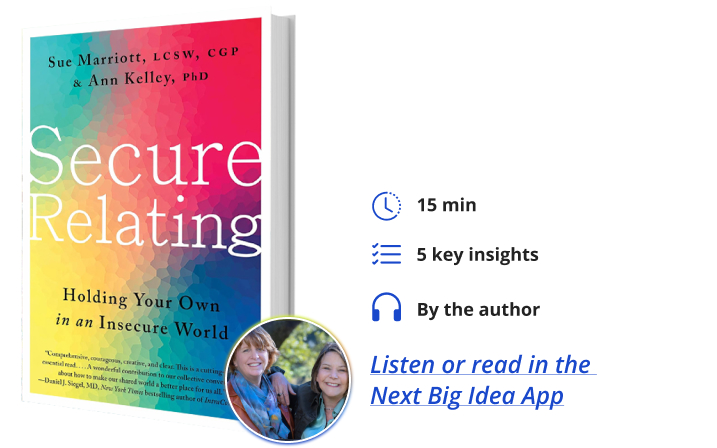Sue Marriott and Ann Kelley are psychotherapists and co-hosts of the podcast Therapists Uncensored. They are also a married couple, raising a menagerie of kids, pets, and plants.
Below, co-authors Sue and Ann share five key insights from their new book, Secure Relating: Holding Your Own in an Insecure World. Listen to the audio version—read by Sue and Ann—in the Next Big Idea App.

1. It’s no surprise we’re overwhelmed.
We’re bombarded with threats that we feel helpless to change: images of deadly wars, ongoing political polarization, and climate chaos, to name a few. We are overwhelmed, and there’s no relief in sight. Our bodies aren’t designed to endure ongoing stress. We’re designed to be social and connected and care for one another. If we feel a sense of threat, we quickly turn on our brain’s circuitry for self-protection mode. When activated, protective instinct shuts down our higher thinking, but it’s supposed to be temporary. When the stress isn’t temporary and becomes chronic, we have an amygdala hijack. We think that a big problem today is that our collective amygdala has been taken over and has hijacked higher thinking. This is leading us to become more disconnected from one another.
We’ve lost contact with the higher resources in our collective mind. When our protective circuit is in charge, we don’t have any discernment, we can’t see nuance, and we’re prone to jump into action—both inside our relationships and how we react in the world. This quirk is used against us, often intentionally. We’re much easier to control when we’re in our lower mind. From this insecure and defended state, criticism evokes defensiveness, blame invites childlike counter-blame, and relational bitterness and resentment become accepted as normal. Then, to cope, we often either isolate, numb out, or band together in collective hate. That hate makes us want to mobilize against “others.”
We’re actually being directed to fear. This armored dance becomes a cycle reinforced by others in the same boat. It’s like a toxic loop, but it doesn’t have to be that way. While blame, cynical mistrust, and hopelessness are contagious, the good news is that so is realistic optimism, empathy, and connection. However, we can’t dial up optimism and care whenever we want. We must learn how to create that in ourselves and others. This is difficult because you can’t change what you don’t see. Discovering how to tell if you are operating from this reactive, defensive place or a more secure state is not easy.
Imagine yourself in an argument with your partner or your teenager, and suddenly, they catch themselves, and they say, Ah, I can hear how I’m coming across. I must be more upset than I think. That kind of moment of self-awareness would be heaven. It works too, because it takes the wind out of the sails of escalating tension. Just one move towards secure relating is enough to calm a situation down.
2. Knowing patterns of defensiveness really matters.
While nobody fits neatly into a single box or behaves the same way every time, we do have predictable tendencies of reactivity when upset during relational distress. We tend to either move toward or away from that distress.
What do you tend to do when you get upset in relationships? Do you immediately know how you’re feeling? Do you feel things strongly and want to work it out immediately? Or does dealing with all those emotions in yourself or anyone else make you want to poke your eyes out? Are you afraid to lose your independence? Are you more afraid of losing your relationship? Are you super decisive? Or do you try to figure out what you want? These differences are fascinating, yet so predictable, once you understand what is going on underneath.
“We often think we’re just being independent, but in reality, we are cut off from the feelings of love and vulnerability necessary to stay in close relationships.”
There is much research from psychology and neuroscience that can help you understand your personal patterns and give you agency to build more secure, enduring, and enjoyable relationships. We explain the science and methods at length in our book. For example, we dive into the modern attachment regulation spectrum, which helps you better identify why you react the way you do. It helps you visualize your activation level, meaning how upset you are, and it helps you understand what to do after realizing what’s underneath.
Imagine a spectrum that starts on the left side with a dark blue color, gradually lightens towards the middle, where it turns green, and then as you move further right, it shifts to orange before finally ending with red on the far right. The green zone in the middle represents your secure zone, which indicates that you are grounded. As you move toward the red zone, your anxiety and activation levels increase. If you reach the red zone, it means you are in full preoccupied mode. This might look like many big feelings and an intense sense of urgency. On the other hand, if you shift left towards the blue zone, you become more withdrawn, zipped up, and highly rational. We often think we’re just being independent, but in reality, we are cut off from the feelings of love and vulnerability necessary to stay in close relationships.
By recognizing your unique strategies for managing distress, you will be much more adept at recognizing when you’re veering off course. This not only helps you function at your best, but also fosters a sense of security and connection with those around you, optimizing the chances that they will return the favor and relate from their most grounded, secure place as well. Figuring out how you dysregulate is one thing, but understanding what gets under your skin and why you react the way you do will make these changes stick.
3. Modern attachment can help us shift towards more secure relating.
While it’s exciting that many people see the value in this research, many individuals still don’t fully understand the concepts. This can lead to confusion and misinformation even among mental health professionals. The research on attachment started over 70 years ago. Fast forwarding, we understand now that our attachment patterns are not exclusively shaped by our early caregiver experiences but also by cultural influences, life circumstances, and significant relationships throughout our lives and even in previous generations.
We can apply contemporary science to our everyday lives by moving away from rigid categories that don’t accurately describe our complex emotions and experiences. For instance, instead of saying, I am preoccupied, we can acknowledge that we’ve fallen into a preoccupied state and work towards returning to a more secure state of mind. This approach makes more sense because no matter our personal history, we can all return to a secure state of mind at any moment. It’s a more hopeful and realistic way of thinking about emotional well-being.
Moving towards a more secure self is not dependent on what you know or have studied. It’s possible to be an expert in neuroscience yet not operate from your most secure state of mind. Conversely, it’s possible to be a single mother of five, know nothing about the brain, and raise mostly secure children without formal instruction. This journey is so cool because once you begin to recognize the dynamics, you begin having all these light bulb moments of cringy insight and hold the power to foster health and well-being in yourself and others.
4. We can’t be secure by ourselves.
Secure attachment cannot exist in isolation. It is inherently collective. In fact, the global majority faces the impact of historical oppression in current societal structures that uphold inequality to benefit those in power. This is especially true for marginalized communities, including peoples of color, indigenous people, LGBTQ+ individuals, and those who are neurodiverse, chronically ill, overweight, disabled, or poor. Their experiences of relational and attachment security and insecurity can be fundamentally different from those in privileged positions.
“Our brains are wired to see ourselves and our systems as normal and feel most comfortable when our beliefs and values are reflected back to us.”
As mental health providers, policymakers, educators, medical practitioners, and institutions, it’s crucial that we consider the systematic factors contributing to the suffering of those excluded from existing power structures. If we don’t, we can unintentionally promote the harmful notion that individuals are solely responsible for their collective pain and suffering.
Our brains are wired to see ourselves and our systems as normal and feel most comfortable when our beliefs and values are reflected back to us. That’s why when someone seems odd or different, our protection system activates, and we discriminate, reject, or simply pressure others to conform to what feels more natural to us.
5. Secure relating helps you, your relationships, and the world.
One of the beauties of secure relating is that when your connection circuit is in charge, we are less defensive, less prejudiced, less likely to believe in conspiracy theories, and more likely to recognize similarities in people who are different.
Secure relating means we operate from our whole and wise mind, our heart is online, and our neural systems are integrated and working in balance. In that place, we can appreciate complexity, discern nuance, and are naturally more compassionate and generous. This is why it’s so important that we fight that amygdala hijack to keep our higher mind at the wheel.
Secure relating does not mean you’re a pushover or a doormat. It does not mean you are nice. When you’re in a secure relating circuit, that is when you have your best boundaries and your strongest mind, and rather than being reactive, you’re going to be able to respond in the most effective way possible. We all need that right now as a collective world; we need each other to be in our best selves.
To create meaningful change, you need to engage in a process, and you’ll likely need a guide. Learning the takeaways from the research on modern attachment and relational neuroscience is a fantastic start. This pathway teaches how our defensive neural networks are shaped in our early years and how they appear in our adult relationships. It teaches how to regulate better and co-regulate rather than co-disregulate one another. Being in a secure state feels good and is beneficial for both your organs and your relationships. A relationship that functions securely sets a high positive bar for everyone involved. Similarly, a populace that functions securely can manage complex situations with reason, compassion, and strength. By being on this journey together, we can be part of the solution for healing our toxic divisions.
To listen to the audio version read by co-authors Sue Marriott and Ann Kelley, download the Next Big Idea App today:





























